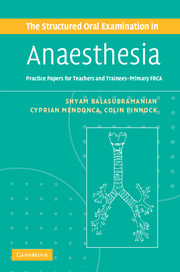SOE 9
Published online by Cambridge University Press: 21 January 2010
Summary
Key topics: protein metabolism, adrenal hormones, respiratory system compliance
Q1 Protein metabolism
What is the structure of a protein?
Amino acids form the basic units of proteins. Each amino acid has a carboxyl group (COOH) and amine group (NH2) attached to a carbon atom. Chains of amino acids are called peptides or polypeptides. These chains increase in size to form proteins.
What are glycoproteins and lipoproteins?
These are proteins containing carbohydrates and lipids respectively.
What you mean by essential amino acids? Can you name some essential aminoacids?
Those amino acids that are not synthesised endogenously and are dependent on dietary source alone are called essential amino acids:
Methionine, arginine, threonine, tryptophan.
Valine, isoleucine, leucine.
Phenylalanine, lysine.
What are the metabolic functions of amino acids?
Protein synthesis.
Several hormones, catecholamines and neurotransmitters are formed from specific amino acids. Methionine, for example, is converted to S-adenosyl methionine, which is an active methylating agent in the synthesis of epinephrine.
Fatty acid synthesis.
Gluconeogenesis.
Citric acid cycle.
Transamination.
Precursors for purines and pyrimidines.
What is the function of purines and pyrimidines?
These ring based structures are ubiquitous in the body and are the base components in the ribonucleotides and deoxyribonucleotides that code RNA and DNA respectively.
Purines and pyrimidines contain high-energy phosphoryl bonds which are involved in several phosphate transfer reactions of ATP and other nucleoside triphosphates (GTP, UTP).
- Type
- Chapter
- Information
- The Structured Oral Examination in AnaesthesiaPractice Papers for Teachers and Trainees, pp. 201 - 225Publisher: Cambridge University PressPrint publication year: 2006



